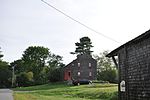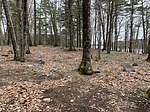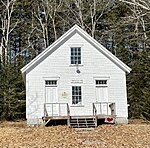Wolfe's Neck Farm
Wolfe's Neck Center for Agriculture & the Environment (formerly Wolfe's Neck Farm) is a sustainable coastal farm in Freeport, Maine, United States. Located at 184 Burnett Road, the farm was established in 1959 by Philadelphia natives Eleanor Houston Smith (1910–1987) and Lawrence Smith (1902–1975).The farm was given to the University of Southern Maine by Eleanor Smith in 1985. Twelve years later, Wolfe's Neck Farm Foundation took over the management of the property.In addition to the farm, the property, which is situated on four miles (6.4 km) of Casco Bay coastline, also contains the main office building (located in the 1820s-built Little River House; renovated in 2017), a barn, a campground (Wolfe's Neck Oceanfront Camping at Recompence Shore Campground), a farm store and cafe, community gardens, hiking trails, the 1890-constructed Mallet Barn (at the end of Wolfe's Neck Road), the Banter House (restored in 2014; at the junction of Burnett and Wolfe's Neck Roads) and the Pote House and Barn (restored in 2017; on Wolfe's Neck Road). The Wishcamper Livestock Education Barn was built in 2017 where a barn, torn down in 2008, previously stood. An organic dairy barn, built at a cost of $1 million, opened in May 2019.Wolfe's Neck Farm was renamed Wolfe's Neck Center for Agriculture & the Environment in October 2017. In 2019, Wolfe's Neck Center received a donation of $25,000 from Kennebec Savings Bank "to support enhancements to its facilities."
Excerpt from the Wikipedia article Wolfe's Neck Farm (License: CC BY-SA 3.0, Authors).Wolfe's Neck Farm
Burnett Road,
Geographical coordinates (GPS) Address Phone number Website Nearby Places Show on map
Geographical coordinates (GPS)
| Latitude | Longitude |
|---|---|
| N 43.830781 ° | E -70.071258 ° |
Address
Wolfe's Neck Farm
Burnett Road 184
04032
Maine, United States
Open on Google Maps










